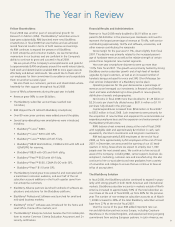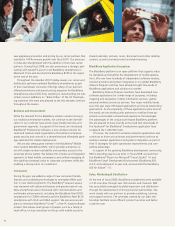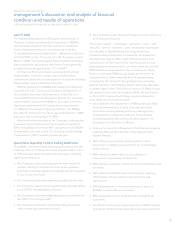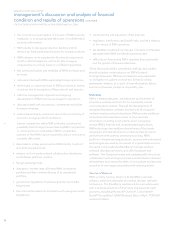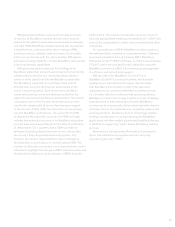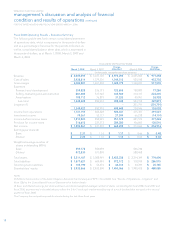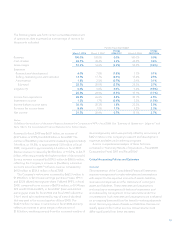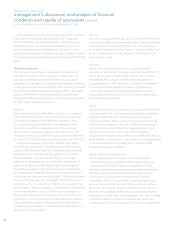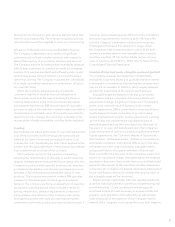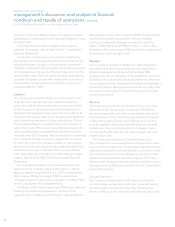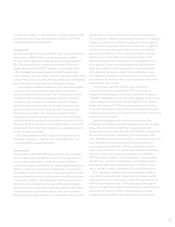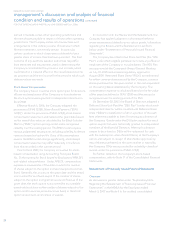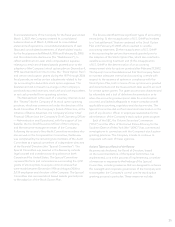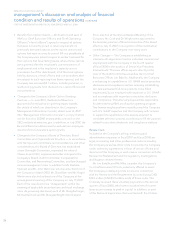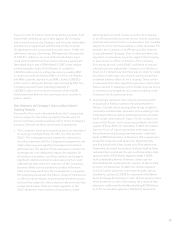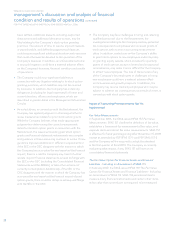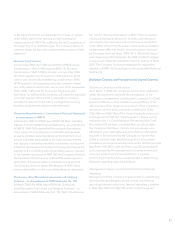Blackberry 2008 Annual Report Download - page 21
Download and view the complete annual report
Please find page 21 of the 2008 Blackberry annual report below. You can navigate through the pages in the report by either clicking on the pages listed below, or by using the keyword search tool below to find specific information within the annual report.
19
The following table sets forth certain consolidated statement
of operations data expressed as a percentage of revenue for
the periods indicated:
For the Fiscal Year Ended
March 1, 2008 March 3, 2007 Change
2008/2007 March 4, 2006 Change
2007/2006
Revenue 100.0% 100.0% 0.0% 100.0% 0.0%
Cost of sales 48.7% 45.4% 3.3% 44.8% 0.6%
Gross margin 51.3% 54.6% (3.3%) 55.2% (0.6%)
Expenses
Research and development 6.0% 7.8% (1.8%) 7.7% 0.1%
Selling, marketing and administration 14.7% 17.7% (3.0%) 15.2% 2.5%
Amortization 1.8% 2.5% (0.7%) 2.4% 0.1%
Sub-total 22.5% 28.0% (5.5%) 25.3% 2.7%
Litigation (1) 0.0% 0.0% 0.0% 9.8% (9.8%)
22.5% 28.0% (5.5%) 35.1% (7.1%)
Income from operations 28.8% 26.6% 2.2% 20.1% 6.5%
Investment income 1.3% 1.7% (0.4%) 3.2% (1.5%)
Income before income taxes 30.1% 28.3% 1.8% 23.3% 5.0%
Provision for income taxes 8.6% 7.5% 1.1% 5.2% 2.3%
Net income 21.5% 20.8% 0.7% 18.1% 2.7%
Notes:
(1) Reflects the resolution of the patent litigation between the Company and NTP in fiscal 2006. See “Summary of Operations – Litigation” and
Note 12(b) to the Consolidated Financial Statements for further details.
Revenue for fiscal 2008 was $6.01 billion, an increase of
$2.97 billion, or 97.9%, from $3.04 billion in fiscal 2007. The
number of BlackBerry devices sold increased by approximately
7.4 million, or 114.8%, to approximately 13.8 million in fiscal
2008, compared to approximately 6.4 million in fiscal 2007.
Device revenue increased by $2.55 billion, or 115.2 %, to $4.77
billion, reflecting primarily the higher number of devices sold.
Service revenue increased by $300.5 million to $860.6 million,
reflecting the Company’s increase in BlackBerry subscriber
accounts since fiscal 2007. Software revenue increased by
$61.2 million to $234.4 million in fiscal 2008.
The Company’s net income increased by $662.3 million to
$1.29 billion, or $2.31 basic earnings per share (“basic EPS”)
and $2.26 diluted earnings per share (“diluted EPS”), in fiscal
2008, compared to net income of $631.6 million, or $1.14 basic
EPS and $1.10 diluted EPS, in fiscal 2007. Basic and diluted
earnings per share for fiscal 2008 and fiscal 2007 reflect the
3-for-1 stock split implemented by way of a stock dividend
that was paid in the second quarter of fiscal 2008. The
$662.3 million increase in net income in fiscal 2008 primarily
reflects an increase in gross margin in the amount of
$1.42 billion, resulting primarily from the increased number of
device shipments, which was partially offset by an increase of
$467.2 million in the Company’s research and development
expenses and sales and marketing programs.
A more comprehensive analysis of these factors is
contained in “Summary Results of Operations – Fiscal 2008
Compared to Fiscal 2007 and Fiscal 2006”.
Critical Accounting Policies and Estimates
General
The preparation of the Consolidated Financial Statements
requires management to make estimates and assumptions
with respect to the reported amounts of assets, liabilities,
revenues and expenses and the disclosure of contingent
assets and liabilities. These estimates and assumptions
are based upon management’s historical experience and
are believed by management to be reasonable under the
circumstances. Such estimates and assumptions are evaluated
on an ongoing basis and form the basis for making judgments
about the carrying values of assets and liabilities that are not
readily apparent from other sources. Actual results could
differ significantly from these estimates.


